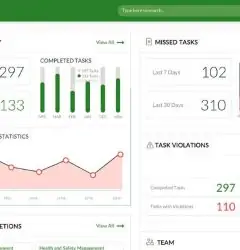19 Jun

Compliance management refers to an essential process where company managers ensure that the company is complying with laws and standards. It involves planning, organizing, controlling, and leading the company’s activities such as internal audits, third-party audits, security procedures, and control, developing reports and maintaining proper documentation, creating and implementing policies and necessary procedures in order to ensure compliance. All of this is done to avoid the consequences formed when a company fails to comply with regulations, laws, and standards that have high potential costs.
The Importance of Compliance Management
Compliance management allows you to stay updated with federal and state legislation, as it is essential for all businesses. It is a must for every company to comply with laws and manage personnel in a better way. Non-compliance will only lead to heavy penalties, jail terms (mostly for senior management). The human resource teams are responsible for ensuring that organizations are treating all of their employees equally, fairly, and are operating legally.
The compliance management system provides you insight into your company’s operations. You are enabled to monitor, track, and measure compliance and know who is putting what efforts, at what time, and in what ways.
What Does A Compliance Manager do?
A compliance manager ensures that the organization is operating in accordance with the state’s laws and regulations and that they are not violating any of the rules and regulations set by the government so as to avoid penalties and other charges. These managers plans, organize, control and lead the organization’s operations to make sure that everything is under constant observation. These company’s operations may include internal and third-party audits, security procedures, creating reports and documentation, maintaining company policies, and ensuring their implantation.
However, one main role performed by a compliance manager is managing behavior. Safe, responsible, or ethical behavior is s source of motivation for various guidelines and regulations.
The compliance officer maintains the tone, which helps to maintain desired behaviors. It is done through plans, policies, communication, actions, and reporting. Thus, an independent and strong leader with good communication skills is required for this job.
Compliance managers communicate everything to upper-level management or C-suite management so as to set clear business goals and to put efforts to meet them in an environment that is industry appropriate compliant environment.
Who Is Responsible for Compliance Management System?
Compliance management and risk management work parallel to each other. It is everyone’s job to ensure compliance, and that is why compliance and risk management teams must have representatives from all departments of an organization. All of these individuals represent their departments. Hence, it gets easier to understand the operations of all departments and if there are any risks or potential violations to address.
Under the supervision of the compliance risk management officer and the DPO, this team develops and monitors an effective compliance plan. This team is responsible for reviewing external and internal audits and helps to find any vulnerabilities. It also provides recommendations for altering the company’s policy and ways to minimize potential threats. Usually, people from the IT department are greatly involved, and they perform tactical operations.
How To Create a Culture of Compliance
One of the reasons behind having a representative from each business unit of a company is for creating a ripple effect for all employees. Compliance is everyone’s responsibility, and this message must be spread in the company. This is the only way how you can build a culture of compliance in your organization.
In addition to employees’ day to day tasks, the member of the compliance team must work together for:
- Creating a culture of accountability in the organization. It also includes top management.
- Enabling a system for each employee so they can report any compliance concerns.
- Adopt a workplace technology that can help with compliance issues. It includes internal auditing, active monitoring, and predictive modeling.
- Addressing issues as soon as they appear and maintaining proper documentation from complaints and inquiries to vulnerabilities and breaches.
- Self-monitoring the efforts of the team so as to ensure effectiveness.
- Ensuring that all company workers receive proper compliance training and that they have knowledge of risk management. Also, educating them about compliant behavior and corporate ethics. Most organizations develop learning modules in their Learning Management System (LMS). Others bring qualified trainers.
Compliance Management Framework – The Necessary Elements
A compliance management framework serves as a building block of your compliance program. Here are four necessary elements that every organization must have in order to build an excellent framework. It can also be called a set of procedures for companies to follow in order to conduct business while complying with the regulations, laws, and specifications. It involves processes, tools, controls, and functions that are pre-determined by the directors and top management of every organization. Some benefits of these compliance procedures may include:
- Prevention of violating or breaking the law that may affect the organization’s reputation and results in heavy penalties.
- Provision of guidelines for business operations and their implementations.
- Assigning roles to different individuals in an organization and holding them accountable for their work performance.
- Easy data collection and information gathering for developing reports.
Thus, every organization needs to have a good compliance management framework for its business growth and success. There is a variety of software in the market that can be selected for compliance management.
A compliance management framework must be effective. Here are four necessary elements that make a compliance management framework useful.
Compliance program
Every business needs to comply with the set of rules and regulations pre-defined by the law, and I order to do so, a compliance management program must have:
- Policies – Management should set certain policies and make their employees follow them while they work in the organization. It must be carefully observed whether or not all employees, from the entry-level to the top level, are following these policies or not.
- Processes – Based on services and products that a company offers, a company must have a set of processes to be followed for ensuring that everything is being done according to the laws.
- Training – Every organization must train its workers. Training is a part of their job and is done during the hiring process and also when some new policies and rules are being implemented.
- Monitoring – A monitoring policy will help the management to check whether or not the workers are following the rules and policies.
- Corrective actions – When a mistake happens, corrective behavior must be adopted to ensure the mistake never gets repeated.
Strong Commitment to The Board of Directors
The board of directors has the complete control of an organization, and they serve as the management oversight in any company. A company’s management must be committed to ensuring that all business operations of the company will abide by the rules and regulations set by the law. Being members of the top-level management, they should appear to be an example for lower-level employees.
A code of conduct should be formed by the board of directors so as to communicate their expectations and to let their employees know about company policies for maintaining compliance.
Consumer Complaint Program
For creating a successful compliance management system, a company must collect feedback from its consumers. Consumer complaint programs are beneficial in many ways.
- They help the company in knowing their satisfactory products and those that are not or need improvements. By collecting such information, a company can understand how it can provide its customers with better products and services.
- A company can understand what type of concerns and complaints its customers have, and it can look for ways to address these customer complaints.
- A customer complaint program helps an organization to introduce alternative services and products if its customers are not satisfied with the existing ones.
- It helps a company to enhance its credibility by understanding its customer better and addressing their concerns in a better way. It leads to business growth and satisfied customers.
- A company can communicate with its customers and answer their concerns through a customer complaint program. It helps to improve an organization’s reputation in the market.
Audits From A Third-party Or An Independent Body
A compliance audit helps an organization to know whether or not it is complying with laws and regulations of the stats. It also helps the management to know if the company is working according to its policies and all employees all adhering to the set of pre-determined rules communicated by the board of directors. Such audits are done by a third-party or an independent body so as to avoid biased reports.
Compliance audits should be a regular practice for every company. The board of directors must determine how often these audits should be performed. The top-level management must provide the third-party with all the resources and materials required for conducting the audit.
When audits are done, reports are generated and documented carefully. If there are compliance issues, corrective behavior is used to remove all such issues. The audit reports and provided to the senior management or the board of directors for future decisions.
What Are The Benefits of The Compliance Management
Compliance management allows an organization to stay updated with all state’s laws, regulations, and requirements. Every business must comply with laws in order to operate. Not doing so will lead to many complications, such as paying heavy penalties and serving jail-terms.
To be better said, compliance management is beneficial for every organization as it helps to stay in accordance with state laws for businesses. These laws may include employment laws and other rules and regulations for operating a business.
Challenges of Compliance Management
Some of the major challenges faced by the management whole working on compliance management are the following:
- Usage of various tools over different departments leads to an increase in costs. It creates doubts about data that usually keep risk and compliance managers from making well-informed and timely decisions.
- Governance, Risk, and Compliance (GRC) requirements have made it difficult to achieve excellence in operations using manual methods. Hence the profits are usually low and create major challenges.
- Risk and compliance tools that are available today for addressing compliance workflows are not providing enough help to businesses for eliminating compliance issues.
- The increasing number of compliance management activities makes it harder to achieve a holistic view of an organization for taking relevant actions. Hence, management fails to address issues in terms of driving business strategies.
Creating An Effective Compliance Management Program
An effective compliance management program allows an organization to maintain standards that meet the law’s pre-defined requirement for operating a business. A company can benefit a lot from a compliance management program, and thus, it should put extra attention when creating a compliance management program.
The Board of Directors
The board of directors is the driver of any organization. They set objectives, make policies, set rules, and communicate their expectations to all their employees so as to meet their business goals.
Compliance Program
It is a program that contains all documentation, such as formally written documents, procedures and policies, monitoring and training, and corrective actions. Using compliance management software allows a company to trust the collected data.
Consumer Complain Management Program
Responding to customer concerns is what excellent companies do. Tracking and monitoring the products and services that gain a positive as well as negative responses is beneficial to understand how a company can improve its business operations.
Compliance Audit
Third-party audits will always help an organization to know how far or close it is to meet the pre-defined standards of business operations. Such audits should be done by an independent body so as to eliminate any biases.
What People Are Involved In Compliance Management
There is a variety of people, internal and external stakeholders involved in a compliance management system.
Senior Management
After establishing the business objective, senior or top-level management work on the process of vendor risk management (VRM). And being a part of the process, senior management must review both external and internal documentation in order t ensure that the organization is in accordance with the government’s required standards and controls.
Compliance Officer
Compliance officers are responsible for overseeing the entire compliance management system. He plays the role of a captain and is in charge of every task, from researching to updating all the policies, rules, processes, and procedures.
Front-Line Employees
Customer service representatives of any organization act as the front line employees and maintain a defense against any improper business activities. Front line employees require proper training so as to be prepared for dealing with compliance issues.
What Is Compliance Management System
A compliance management system keeps you in accordance with Fair Lending regulations. It provides you control over your company’s efforts for compliance. If you do not have a compliance management system, you might not be able to track your organization’s compliance strategies and monitor whether or not your business operations are complying with pre-defined laws and regulations.
It is an integrated system that consists of written documentation, processes, functions, tools, and controls which help a company to comply with legal requirements and minimize the risk of harming its consumers due to the violation of laws.
A compliance management system helps to monitors all business units and departments of your organization, from sales to administration and advertising. A well-developed compliance management system addresses the risks as soon as they appear.
Who Cares About Your Compliance Management System
Your Capital Partner
Your sources of funding need evidence that you are in compliance with the government’s pre-defined laws and regulations. They need to be sure about your performance as a business like how you address concerns of your consumers, and what steps are you taking to implement a compliance management program.
The Consumer Financial Protection Bureau
With a compliance management system, organizations are enabled to respond to all CFPB investigation or inquiry rapidly by providing them the recorded data in real-time.
Business Growth
A well-developed and well-implemented compliance system fairly minimizes the money, time, and human efforts spent on compliance. The information gathered by your CMS will allow you to make well-informed decisions.
What Are The Different Types of Compliance
In any company, there are four types of compliance:
- One-time Compliance – Certificates, Licenses, Registrations, and other related compliance.
- Recurring Compliance – These are annual, bi-annual, quarterly, and monthly filings compliance. TDS return, GST return, PF return, etc.
- Ongoing Compliance – Procedures, provisions, displays, registers, and many other related compliances. Client’s KYC records, prevention of any type of harassment such as sexual harassment, etc.
- Event-based related compliance is done by an organization when any event occurs. Such as when a workplace injury occurs, the appointment of additional director, change in Pan Data, etc.
What Is Authority Compliance Management
Authority Compliance Management emphasizes job and task requirements. Compliance personal serve as necessary tools for compliance.
What Is Statutory Compliance Management
It provides a legal framework and foundation for ensuring that employees are being treated ethically concerning statutory issues. These issues may involve paternity leave, social security, minimum wage, etc.
What Is Regulatory Compliance Management
It provides a set of policies, guidelines, and activities that are must in order to follow regulations. It proves that you are in compliance with pre-defines laws and statutes.
What Is Security Compliance Management
Security compliance management puts focus on technology, procedures, and processes that are adopted to protect data and information from theft, loss, or breach.
What Is Risk Compliance Management
With risk compliance management, risks are first identified and assessed. After which procedures and policies are developed and implemented in order to meet compliance requirements.
What Is Asset Management Compliance
Investment management firms usually use this compliance. It helps to highlight processes and policies for protecting investors, maintaining financial stability, and reputation of the firm.
How Formal Is A Compliance Management System?
A compliance management system varies from organization to organization. It is designed according to a company’s size and its complexity. A small-scale financial institution, such as one branch community bank that has only ten workers and assets of around $50 million, is likely to have an informal program. On the contrary, a regional community bank will have a fairly formalized system.
What Are Some Benefits of Compliance Management Software Solutions
Following are some major benefits of Compliance Management Solutions:
- Real-time tracking, reporting, and intelligence that helps to make well-informed decisions.
- Information shared is fairly transparent (ratings, activity, and issues)
- Workflow and activity automation
- Enhanced efficiency of compliance management.
- It helps to facilitate more information-driven discussions.
- Fewer chances of errors and risks.




Ecodocs